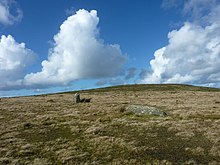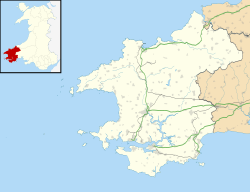
Summary
Waun Mawn (Welsh for "peat moor") is the site of a possible dismantled Neolithic stone circle in the Preseli Mountains of Pembrokeshire, Wales. The diameter of the postulated circle is estimated to be 110 m (360 ft), the third largest diameter for a British stone circle.[1][2]
 Standing stone and prostrate stone near Cnwc yr Hŷdd, Waun Mawn in October 2012 | |
 Shown within Pembrokeshire | |
| Location | Near Tafarn y Bwlch, Brynberian, Pembrokeshire, Wales |
|---|---|
| Coordinates | 51°58′18″N 4°47′28″W / 51.9716°N 4.7912°W |
| Type | Stone circle site |
| History | |
| Periods | Neolithic |
| Site notes | |
| Archaeologists | Mike Parker Pearson |
The site is located at grid reference SN08393403 around 1 mile (1.6 km) to the south west of Brynberian.[3] This tract of moorland sits on the southern slopes of the 339 m (1,112 ft) hill top of Cnwc yr Hŷdd, just to the north of the broad east-west ridge of the Preseli range.[4]
There are four remaining stones, one standing and three prostrate. Nearby are the "Troed y Rhiw" standing stones and to the west of the main group is another solitary standing stone, the 'Waun Mawn Stone', measuring some 2.3 m (7 ft 7 in) high.[5]
Recent findings edit
During 2017 and 2018, excavations by the UCL team of archaeologist Mike Parker Pearson, led to a proposal that the site had originally housed a 110 m (360 ft) diameter stone circle of the same size as the ditch at Stonehenge[6][7] The archaeologists also postulated that the circle also contained a hole from one stone which had a distinctive pentagonal shape, very closely matching the one pentagonal stone at Stonehenge (stonehole 91 at Waun Mawn and stone 62 at Stonehenge).[6][7] Both circles appear, according to some researchers, to be oriented towards the midsummer solstice.[6]
Following soil dating of the sediments within the postulated stone holes, via optically stimulated luminescence (OSL), it has been argued, by Parker Pearson, that the circle of stones was built c. 3400–3200 BC and then, before 2120 BC, was disassembled, dragged across land and reassembled at Stonehenge in Wiltshire, some 140 mi (230 km) distant.[8] Parker Pearson's proposals have been published in the journal Antiquity.[1] This postulated migration of the stones was likened by the researchers to the story told by Geoffrey of Monmouth, in his 12th-century History of the Kings of Britain, of Merlin taking the stones of the Giant's Dance circle in Ireland to Stonehenge.[6]
The site and its connection with Stonehenge was the subject of the BBC Two programme, Stonehenge: The Lost Circle Revealed, with Parker Pearson and Professor Alice Roberts. Broadcast was on 12 February 2021,[1][6][9][10] and reported in New Scientist on 20 February 2021.[11]
Work in 2021 led Pearson and his colleagues to conclude that only 30% of the proposed stone circle at Waun Mawn had been completed, but that perhaps as many as 17 stones had been erected so between eight and 13 had been removed in antiquity, far fewer than the perhaps 80 bluestones that once stood at Stonehenge. That work uncovered no new evidence connecting Waun Mawn and Stonehenge.[12]
Two geological articles published in 2022 showed that there is no link between Waun Mawn and the supposed "bluestone quarries" at Craig Rhosyfelin and Carn Goedog, and no link between Waun Mawn and Stonehenge.[13][14] In a 2024 study published in Holocene journal, Brian John re-examined the geological and archaeological evidence from the site, and concluded that the "lost circle" of standing stones had never existed, and that there was no evidence to demonstrate a link with Stonehenge. He concluded that there had been considerable "interpretative inflation" at the site, driven by a desire to show a Stonehenge connection.[15][16]
References edit
- ^ a b c Pearson, Mike Parker; Pollard, Josh; Richards, Colin; Welham, Kate; Kinnaird, Timothy; Shaw, Dave; Simmons, Ellen; Stanford, Adam; Bevins, Richard; Ixer, Rob; Ruggles, Clive; Rylatt, Jim; Edinborough, Kevan (February 2021). "The original Stonehenge? A dismantled stone circle in the Preseli Hills of west Wales". Antiquity. 95 (379): 85–103. doi:10.15184/aqy.2020.239.
- ^ An Inventory of the Ancient Monuments of Wales and Monmouthshire, Vol.VII. Royal Commission. 1925. p. 260.
- ^ "Waun Mawn (300423)". Coflein. RCAHMW. Retrieved 12 February 2021.
- ^ OL35 North Pembrokeshire [Gogledd Sir Benfro] (Map) (A1bar ed.). 1:25,000. Explorer. Ordnance Survey. 2002. ISBN 978-0-319-23623-9.
- ^ "Waun Mawn Standing Stones, Pembrokeshire: Photos & Visiting Information". Britain Express. Retrieved 13 February 2021.
- ^ a b c d e Pearson, Mike Parker; Pollard, Josh; Richards, Colin; Welham, Kate; Kinnaird, Timothy; Shaw, Dave; Simmons, Ellen; Stanford, Adam; Bevins, Richard; Ixer, Rob; Ruggles, Clive; Rylatt, Jim; Edinborough, Kevan (February 2021). "The original Stonehenge? A dismantled stone circle in the Preseli Hills of west Wales". Antiquity. 95 (379): 85–103. doi:10.15184/aqy.2020.239.
- ^ a b England's Stonehenge was erected in Wales first
- ^ "Stonehenge: Did the stone circle originally stand in Wales?". BBC News. 12 February 2021. Retrieved 12 February 2021.
- ^ "Stonehenge: The Lost Circle Revealed". BBC Two. 12 February 2021. Archived from the original on 12 February 2021. Retrieved 19 February 2021.
- ^ Pearson, Mike Parker; Bevins, Richard; Ixer, Rob; Pollard, Joshua; Richards, Colin; Welham, Kate; Chan, Ben; Edinborough, Kevan; Hamilton, Derek; Macphail, Richard; Schlee, Duncan; Schwenninger, Jean-Luc; Simmons, Ellen; Smith, Martin (December 2015). "Craig Rhos-y-felin: a Welsh bluestone megalith quarry for Stonehenge". Antiquity. 89 (348): 1331–1352. doi:10.15184/aqy.2015.177.
- ^ George, Alison (20 February 2021). "Stonehenge may be a recycled Welsh structure". New Scientist. p. 16.
- ^ Pearson, Mike Parker; Casswell, Chris; Rylatt, Jim; Stanford, Adam; Welham, Kate; Pollard, Josh (2022-01-12). "Waun Mawn and Gernos-fach: the Welsh origins of Stonehenge project Interim report of the 2021 season". Musings and bookmarks about Stonehenge and related stuff. Archived from the original on 2022-01-13. Retrieved 2022-01-30.
In summary, the 2021 excavations provide evidence that only 30% of Waun Mawn's stone circle was ever completed, leaving large gaps on the west and south sides. [...] if Waun Mawn provided some of the bluestones for Stonehenge, these can only have been a small portion of the total.
- ^ Pearce, N.J.G., Bevins, R.E., and Ixer, R.A. 2022. Portable XRF investigation of Stonehenge-- Stone 62 and potential source dolerite outcrops in the Mynydd Preseli, west Wales. Journal of Archaeological Science: Reports 44 (2022), 103525
- ^ Bevins, R.E., Pearce, N.J.G., Parker Pearson, M., Ixer, R.A., 2022. Identification of the source of dolerites used at the Waun Mawn stone circle in the Mynydd Preseli, west Wales and implications for the proposed link with Stonehenge. Journal of Archaeological Science: Reports 45 (2022) 103556.
- ^ John, B.S. 2024. The Stonehenge bluestones did not come from Waun Mawn in West Wales. The Holocene, March 20, 2024 (published online) 30pp.
- ^ "Stonehenge bluestones - the 'giant lost circle' never existed, says new research". Narberth & Whitland Observer. 24 March 2024. Retrieved 28 March 2024.
Further reading edit
- John, Brian (February 2021). "The Lost Circle at Waun Mawn: a commentary (updated)". ResearchGate (Preprint). doi:10.13140/RG.2.2.31504.12802.
External links edit
- Standing stone at Waun Mawn from geograph.org.uk
- Waun Mawn (Tafarn y Bwlch) at megalithic.co.uk, updated 2018


